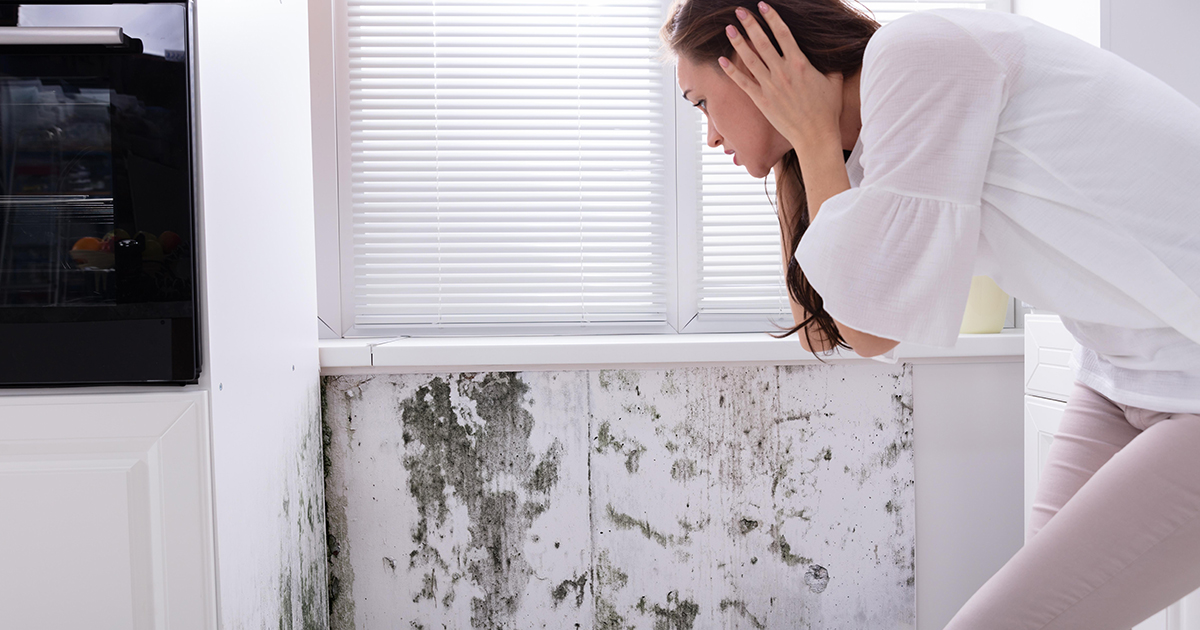Yes, mold can cause headaches through toxic exposure, allergic reactions, and inflammatory responses. Mold releases spores and mycotoxins into the air, triggering headaches in sensitive individuals. Moreover, mold-related headaches often occur alongside other symptoms like fatigue and respiratory issues.
Therefore, understanding the connection between mold and headaches can help you identify potential triggers and find relief. Let’s explore how can mold cause headaches.
What Does A Mold Headache Feel Like?
A mold headache often feels constant pressure or throbbing pain, especially around the temples, forehead, or behind the eyes. Some people describe it as similar to a sinus headache, with heaviness in the head, nasal congestion, and eye strain. It can also be accompanied by fatigue, dizziness, or brain fog, making concentrating harder.
How Does Mold Cause Headaches?
Mold triggers headaches through multiple pathways that affect your nervous system and overall health. When you breathe in mold spores or mycotoxins, your body responds with various reactions that can lead to head pain.
Mold exposure has been linked to headaches since the 1970s when researchers first studied “sick building syndrome.” Today, the World Health Organization recognizes mold as a significant indoor air quality concern. Additionally, studies show that 25% of people exposed to mold develop headache symptoms.
Toxic Exposure Pathway
Some molds produce mycotoxins – toxic compounds that directly affect your nervous system. These toxins can cross the blood-brain barrier and cause neurological symptoms, including headaches.
Common toxic molds include:
- Black mold (Stachybotrys chartarum) produces trichothecenes
- Aspergillus species releasing aflatoxins
- Penicillium molds create ochratoxin A
- Fusarium species producing fumonisins
Research from Duke University shows that mycotoxin exposure can cause headaches within 2-6 hours of exposure. Furthermore, these toxins can accumulate in your body over time, leading to chronic headache patterns.
Allergic Reaction Pathway
Mold spores act as allergens that trigger immune system responses. When your immune system overreacts to mold, it releases histamine and other inflammatory chemicals that can cause headaches.
Allergic headache symptoms include:
- Throbbing pain often on one side of the head
- Sinus pressure and congestion
- Watery eyes and a runny nose
- Sneezing and throat irritation
- Fatigue and brain fog
The American Academy of Allergy, Asthma & Immunology reports that mold allergies affect 10% of the population. Additionally, people with existing allergies are more likely to develop mold-related headaches.
Inflammatory Response Pathway
Mold exposure triggers systemic inflammation throughout your body. This inflammation affects blood vessels in your brain and can lead to headaches.
Inflammatory headaches often feel different from typical tension headaches. Flu-like symptoms, joint pain, and cognitive difficulties may accompany them. Moreover, the inflammation can persist for days or weeks after mold exposure ends.
What Types of Headaches Can Mold Cause?
Sinus Headaches from Mold
Mold commonly triggers sinus headaches by causing inflammation in your nasal passages and sinuses. These headaches feel like pressure around your forehead, cheeks, and eyes.
Sinus headache characteristics:
- Deep, constant ache in sinus areas
- Pain worsens when bending forward
- Facial pressure and tenderness
- Thick nasal discharge
- Reduced sense of smell
Sinus headaches from mold often occur during humid weather or in damp environments. Additionally, they may be accompanied by post-nasal drip and throat clearing.
Migraine-Like Headaches
Mold exposure can trigger migraine-like headaches in susceptible individuals. These severe headaches may include visual disturbances, nausea, and sensitivity to light and sound.
Mold-triggered migraine features:
- Intense, throbbing pain usually on one side
- Nausea and sometimes vomiting
- Sensitivity to light, sound, and smell
- Visual auras or disturbances
- Duration of 4-72 hours if untreated
Research from the American Headache Society shows that environmental triggers like mold cause 30% of migraines. Furthermore, people with existing migraine conditions are more sensitive to mold exposure.
Tension-Type Headaches
Chronic mold exposure can cause persistent tension-type headaches. These feel like a tight band around your head and may be accompanied by neck and shoulder tension.
Tension headache symptoms:
- Dull, aching pain across the forehead
- Feeling of tightness around the head
- Muscle tension in the neck and shoulders
- Mild to moderate pain intensity
- No nausea or visual disturbances
These headaches often develop gradually and may persist for hours or days. Additionally, they tend to worsen with stress and poor sleep quality.
How Do I Know If My Headache Is From Mold?
Location-Based Patterns
Mold-related headaches often follow specific location patterns. Pay attention to where and when your headaches occur most frequently.
Common location patterns include:
- Headaches that worsen at home but improve when away
- Symptoms that increase in basements or damp areas
- Pain that develops in specific rooms or buildings
- Headaches that worsen during humid weather
- Symptoms that will improve with air conditioning or dehumidifiers
Keep a headache diary noting location, timing, and severity. This information helps identify environmental triggers like mold exposure.
Accompanying Symptoms
Mold-related headaches rarely occur alone. They typically come with other symptoms that suggest environmental exposure.
Associated symptoms include:
- Respiratory issues like coughing or wheezing
- Nasal congestion and sinus pressure
- Eye irritation and excessive tearing
- Fatigue and difficulty concentrating
- Skin rashes or irritation
- Throat irritation and hoarseness
If you experience multiple symptoms together, especially in specific locations, mold exposure may be the cause.
Timing and Duration Patterns
Mold headaches often have characteristic timing patterns. Understanding these patterns helps distinguish mold-related headaches from other types.
Typical timing patterns:
- Headaches that develop 2-6 hours after exposure
- Symptoms that worsen overnight in moldy bedrooms
- Pain that increases during rainy or humid periods
- Headaches that improve after leaving the affected areas
- Chronic daily headaches in mold-contaminated environments
Document when your headaches start and stop to identify potential mold connections.
Where Is Mold Most Likely to Cause Headaches?

Indoor Mold Sources
Indoor mold growth creates concentrated exposure that commonly triggers headaches. Certain areas of homes and buildings are particularly problematic.
High-risk indoor locations:
- Bathrooms with poor ventilation and persistent moisture
- Basements with water damage or high humidity
- Kitchens with cooking moisture and poor air circulation
- Bedrooms with water leaks or condensation issues
- HVAC systems with dirty filters or ductwork contamination
The Environmental Protection Agency estimates that 50% of homes have mold problems. Additionally, indoor mold concentrations can be 2-5 times higher than outdoor levels.
Water-Damaged Buildings
Buildings with current or past water damage often harbor mold that causes headaches. Even small leaks can create significant mold problems over time.
Water damage sources include:
- Roof leaks are allowing moisture into the walls and ceilings
- Plumbing leaks behind walls or under floors
- Flooding from storms or burst pipes
- Foundation moisture problems
- Poor drainage around building exteriors
Research shows that people in water-damaged buildings have 50% higher rates of headaches and other health symptoms.
Workplace Mold Exposure
Office buildings and workplaces can harbor mold that triggers occupational headaches. Poor building maintenance and ventilation contribute to these problems.
Familiar workplace mold sources:
- HVAC systems with contaminated ductwork
- Water-damaged ceiling tiles and carpeting
- Poor ventilation in windowless areas
- Humidifier systems with inadequate maintenance
- Storage areas with high humidity levels
Occupational mold exposure affects millions of workers annually. Furthermore, workplace headaches from mold can significantly impact productivity and quality of life.
How Quickly Can Mold Make You Sick?
Mold can make you sick within a few hours to days of exposure, depending on your sensitivity. People with allergies, asthma, or weak immune systems may immediately feel symptoms like coughing, sneezing, headaches, or skin irritation, while others may take longer to notice effects.
What Should You Do If Mold Is Causing Your Headaches?
Immediate Steps for Relief
Take immediate action to reduce mold exposure and alleviate headache symptoms. Quick intervention can prevent symptoms from worsening.
Immediate relief strategies:
- Leave the moldy environment if possible
- Use air purifiers with HEPA filters to remove spores
- Increase ventilation by opening windows and using fans
- Reduce humidity levels below 50% with dehumidifiers
- Clean visible mold with appropriate solutions
Over-the-counter pain relievers may help with acute headache pain. However, addressing the mold source is essential for long-term relief.
Professional Mold Assessment
Consider professional mold testing if you suspect mold is causing your headaches. Certified mold inspectors can identify hidden mold sources and contamination levels.
Professional assessment includes:
- Visual inspection of all areas, including hidden spaces
- Air sampling to measure spore concentrations
- Surface sampling from suspected contaminated areas
- Moisture measurements to identify problem areas
- Written reports with recommendations for remediation
Professional mold testing typically costs $300-800 but provides valuable information for addressing health concerns.
Medical Evaluation
See a healthcare provider if mold-related headaches persist or worsen. Medical evaluation can rule out other causes and provide appropriate treatment.
Medical evaluation may include:
- Detailed symptom history and physical examination
- Allergy testing for mold sensitivities
- Blood tests for mycotoxin exposure
- Imaging studies if severe headaches persist
- Referral to specialists like allergists or toxicologists
Some doctors specialize in environmental medicine and mold-related illnesses. Additionally, they understand the complex relationship between mold exposure and health symptoms.
How Can You Prevent Mold-Related Headaches?

Moisture Control Strategies
Controlling moisture is the most effective way to prevent mold growth and related headaches. Mold cannot grow without adequate moisture levels.
Effective moisture control methods:
- Maintain indoor humidity between 30-50%
- Use exhaust fans in bathrooms and kitchens
- Fix water leaks promptly when discovered
- Ensure proper drainage around your home’s foundation
- Use dehumidifiers in damp areas like basements
The CDC recommends keeping indoor humidity below 50% to prevent mold growth. Additionally, moisture problems should be addressed within 24-48 hours to avoid mold establishment.
Ventilation Improvements
Proper ventilation removes moisture and mold spores from indoor air. Good air circulation prevents mold growth and reduces exposure.
Ventilation improvement strategies:
- Install or upgrade bathroom and kitchen exhaust fans
- Use whole-house ventilation systems for consistent air exchange
- Open windows when the weather permits for natural ventilation
- Ensure HVAC systems have adequate fresh air intake
- Clean and maintain ventilation systems regularly
Research shows improved ventilation can reduce indoor mold levels by 60-80%. Furthermore, better air quality often leads to fewer headaches and respiratory symptoms.
Regular Cleaning and Maintenance
Consistent cleaning and maintenance prevent mold establishment and growth. Regular attention to problem areas keeps mold levels low.
Effective maintenance practices:
- Clean bathrooms weekly with mold-preventing products
- Wash and dry fabrics promptly to prevent mold growth
- Clean HVAC filters monthly during peak usage
- Inspect and clean gutters to prevent water damage
- Address small water leaks before they become significant problems
Use mold-killing cleaners containing bleach or hydrogen peroxide for effective treatment. Additionally, porous materials like carpet should be replaced if they become moldy.
When Should You Seek Professional Help?
Persistent or Severe Symptoms
Seek professional help if mold-related headaches are severe, frequent, or don’t improve with environmental changes. Persistent symptoms may indicate significant exposure or sensitivity.
Warning signs requiring professional attention:
- Daily headaches that interfere with everyday activities
- Severe headaches with neurological symptoms
- Headaches accompanied by breathing difficulties
- Symptoms that worsen despite mold removal efforts
- Multiple family members are experiencing similar symptoms
Don’t ignore persistent headaches, especially if they coincide with mold exposure. Early intervention can prevent more serious health complications.
Extensive Mold Contamination
Large-scale mold problems require professional remediation to ensure safe and complete removal. DIY efforts may be inadequate for extensive contamination.
Situations requiring professional remediation:
- Mold covering more than 10 square feet
- Mold in HVAC systems or ductwork
- Sewage-related mold contamination
- Mold behind walls or in structural materials
- Recurring mold problems despite cleaning efforts
Professional mold remediation costs $500-6,000, depending on the extent of contamination. However, proper remediation is essential for protecting your health and preventing recurrence.
Complex Health Issues
Consider consulting specialists if you have complex health issues related to mold exposure. Some people develop multiple chemical sensitivities or chronic inflammatory conditions.
Specialists who can help include:
- Environmental medicine physicians
- Allergists and immunologists
- Toxicologists specializing in mycotoxins
- Integrative medicine practitioners
- Occupational health specialists
These specialists understand the complex relationship between mold exposure and health symptoms. Additionally, they can provide specialized testing and treatment options.
Frequently Asked Questions
How quickly can mold cause headaches after exposure?
Mold can trigger headaches within 2-6 hours of exposure in sensitive individuals. However, some people may not develop symptoms for days or weeks, especially with low-level chronic exposure.
Can mold cause headaches even if I’m not allergic to it?
Yes, mold can cause headaches through toxic exposure and inflammatory responses, even without allergic reactions. Mycotoxins can directly affect the nervous system and trigger headaches.
Will my headaches go away if I remove the mold?
Headaches often improve significantly after mold removal, but recovery time varies. Some people feel better within days, while others may take weeks or months to recover fully, especially after long-term exposure.
Can small amounts of mold cause headaches?
Yes, even small amounts of mold can trigger headaches in sensitive individuals. Some people react to low mold spores or mycotoxins that wouldn’t affect others.
Are certain types of mold more likely to cause headaches?
Black mold (Stachybotrys) and Aspergillus species are particularly associated with headaches due to their toxic mycotoxin production. However, any mold can trigger headaches in sensitive people.
How can I test if mold is causing my headaches?
Keep a detailed headache diary noting location, timing, and severity. Professional mold testing can identify contamination levels, while a medical evaluation can determine if you have mold sensitivities or allergies.
